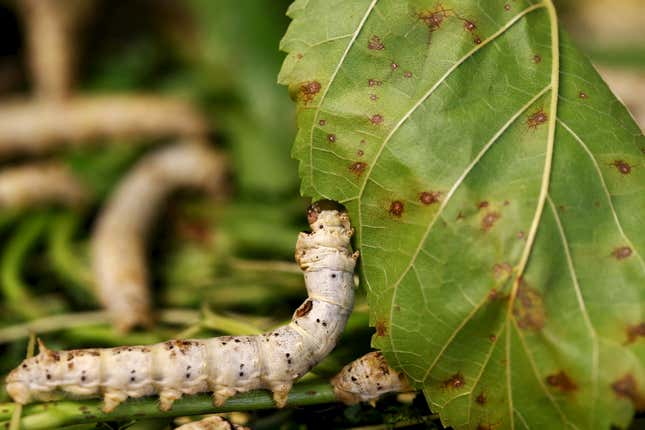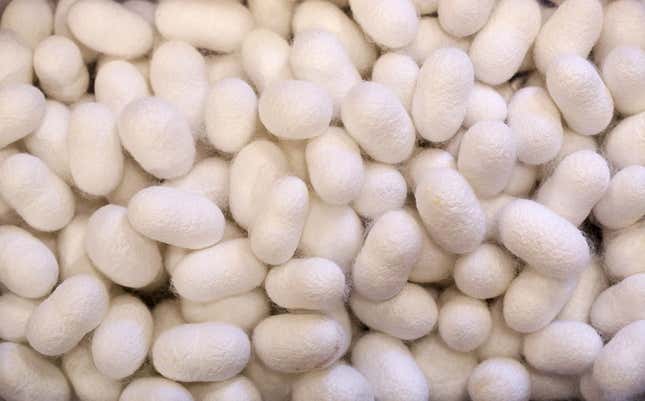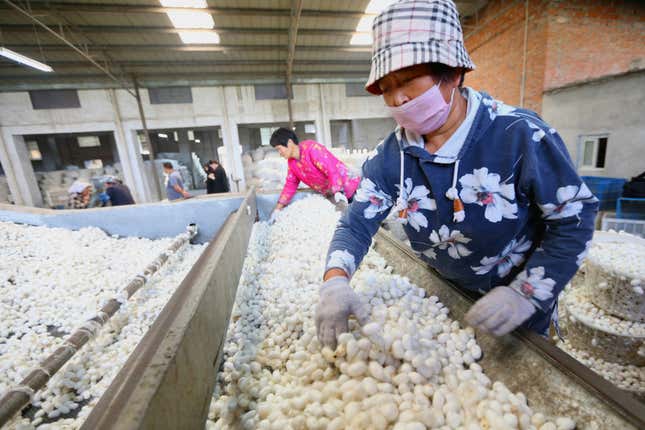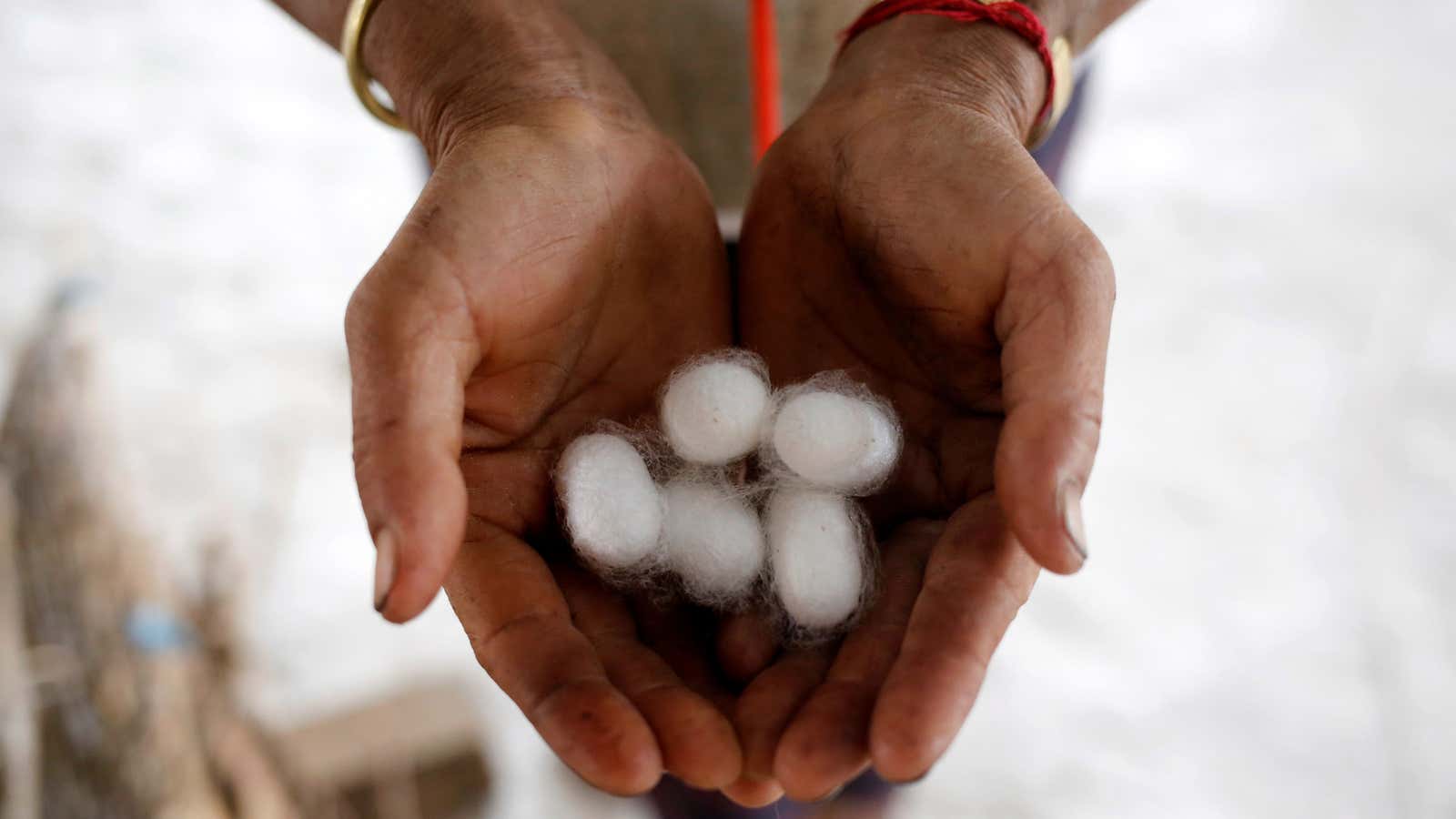ASOS, the popular and rapidly growing British online fashion retailer, has announced a major new change in the products it will—or rather won’t—carry.
Under pressure from the animal-welfare group PETA, the company has joined the likes of Zara, H&M, Gap, and others in ditching mohair, but it’s also going a few steps further. The company’s new policy will ban products using cashmere, silk, feathers (including down), bone, horn, shell (including mother of pearl), and teeth from ASOS’s websites too. It will be fully in effect by the end of January 2019.
But one banned material in the list has caused some to pause: Silk, which is made by silkworms.
“They’re insects,” said one shopper interviewed on a high street by the BBC. Thomas, 33, told the BBC he was “delighted” by ASOS’s other bans—”anything that discourages the hurting or harming of any animal is good”—but was confused by the concern for silkworms. “I think sentient animals definitely, but things like worms—it’s not going to be such a big deal, is it?”
The logic of ASOS’s choice to cease using most of these animal-derived materials is evident. There are awful stories about animal abuse in the farming of mohair and feathers. The boom of the cashmere industry has had serious environmental consequences (pdf). Bone, horn, and teeth, which are typically used for things like buttons, often require a mammal dying. (ASOS, incidentally, already did not sell real fur, and says it will only use leather that is a byproduct of the meat industry and wool from suppliers with good animal husbandry.)
But why silk? And should this be the next product that a conscious consumer must give up?
As with almost anything we wear, buy, or eat, the ethics of wearing or eschewing silk aren’t entirely straightforward, and a person’s decision ultimately comes down to what factors matter most to them. Here are some considerations to keep in mind when making your own decision:
How is silk made?
There’s no getting around this: Silkworms die to produce silk.
There are different types of silk, but the variety we generally refer to when we talk about silk—the one used for stunning saris or flowy dresses—comes from the mulberry silkworm, Bombyx mori. It isn’t actually a worm; it’s a mulberry-leaf-munching moth pupa. It spins silk to make the cocoon for its transformation into its adult form as a winged moth.

That silken cocoon is what silk producers are after, and they want it intact. Once the worm has spun it, but before it’s able to break out and damage it, silk producers will treat the cocoon with hot air, steam, or boiling water, in a process called “stifling.” In sunny, tropical areas, it might also be done by placing the cocoons in bright sunshine. These processes make the cocoon easier to unwind in a single, unbroken filament that can be woven into silk thread.
But when you dip the cocoon in boiling water or bake it with hot air, you’re killing the pupa inside. And huge amounts of pupa are killed in these ways to make the world’s silk. To make one pound of the lustrous, revered material requires about 2,500 or more silkworms.
There is a variety of silk called Peace Silk, or Ahimsa Silk, that doesn’t involve stifling. But animal-welfare advocates, including PETA, are skeptical of how humane this method is. There’s no certification to make sure the process meets standards. One group in India reported female moths being stored in trays to lay eggs at one facility, while the males were “put into the refrigerator and kept in a semi-frozen condition” until they were brought out to mate. Once they could no longer mate, they were discarded.
Can silkworms feel pain?
If you set your ethical bar at whether a living thing died to produce a product, then silk is a fiber you’ll want to avoid.
But for many, like the man the BBC spoke with, the question is whether the living thing involved has the level of consciousness required to experience pain.
Yes, silkworms are cooked in their cocoons, but do they suffer? PETA believes so. “Although worms can’t show their distress in ways that humans easily recognise, anyone who has ever seen earthworms become startled when their dark homes are uncovered must acknowledge that worms are sensitive,” it says. “They produce endorphins and have a physical response to pain.”
The science isn’t so clear though. The release of endorphins, which happens in many animals, including humans, modifies the senses and helps us cope with pain. Earthworms have been found to produce endorphins, which does suggest a response of some sort to pain. But again, silkworms aren’t actually worms, so the earthworm example may not be a particularly useful indicator.
“So, what do these insects feel, if anything?” asked the animal-rights advocate Mark Hawthorne, in his 2013 book, Bleating Hearts: The Hidden World of Animal Suffering. “I put the question to Thomas Miller, an entomologist at the University of California—Riverside, who says that silkworms have a central nervous system, but that they lack structures equivalent to vertebrate pain receptors. ‘Bottom line,’ he says, ‘there is no evidence they experience what you call pain.'” (Hawthorne was skeptical of the answer because, he notes, scientists will occasionally come to one conclusion only to reverse it later as more evidence comes to light.)

Some research indicates that invertebrates don’t experience pain as we understand it. But we aren’t able to determine exactly what they experience.
Last year, Gizmodo asked a group of neuroscientists, biologists, and entomologists what we understand about the way insects sense and experience the world. The general consensus was that, while they may recoil from harmful stimuli, they almost certainly don’t “feel” things the same way we do, and we can’t definitively say what they experience, including whether they feel pain.
The reality is that, right now, we don’t really have a clear answer on whether silkworms feel what we call pain.
What about silk’s costs and benefits to humans?
Silk’s detractors will point to the awful incidents of child labor found in the silk industry in India and Uzbekistan.
But sericulture, or the production of silk and rearing of silkworms, has also been an important part of certain cultures for centuries, especially in India and China, the world’s biggest silk producers. In both countries today it still provides livelihoods to a large number of people.

In rural areas of India, in particular, the work it offers can be invaluable, especially for women. “The sericulture industry has opened up phenomenal employment avenues and helped women to become important players in the decision-making process—whether in the household or in the community at large,” wrote the author of one study of a South Indian village. Another concluded (pdf) that the work women found in sericulture had positive spillover effects on education and nutrition in their households.
If you’re buying silk from a big brand, however, it’s probably coming from an industrial facility in China. Often brands themselves aren’t even sure where their materials originate.
What are the alternatives to silk?
If you decide you’d rather not wear silk, there are man-made alternatives you might consider as substitutes. Unfortunately these may not be any better, ethically speaking.
The main one is rayon, also called viscose, the first-ever man-made fiber. It was developed as a silk substitute in the late 19th century, and is made of regenerated and purified cellulose, usually derived from wood pulp. Despite its main ingredient being plant-based, the process to manufacture it requires highly toxic chemicals. Last year, a report linked H&M, Zara, and Marks & Spencer to viscose factories in China, India, and Indonesia that were causing severe environmental pollution and harming the health of nearby communities.
You could also consider some varieties of polyester, but polyester has been found to leech tiny plastic fibers when washed that end up in waterways, and ultimately, in fish. Microfiber pollution is now recognized as a serious and still growing problem. Even cotton, a thirsty crop and a material that is very hard to recycle, doesn’t come entirely guilt-free.
It’s complicated
So, is it ethical to wear silk? By now it’s probably evident that there’s no one clear answer. It depends on your own personal values and priorities and how you weigh them against one another.
It’s worth remembering, though, that just about any product comes with its own set of ethical tradeoffs. As Clare Press wrote in Vogue of the materials that ASOS banned, “Everything comes with a cost of some sort.”
